Crossed Legs
Crossed Legs is in Church Monument Details.
Around 1150. Church of our Lady Seaton Delaval [Map]. Arched tympanum with head, probably from Tree of Life design. Arch above with zigzag and chamfered hood. In sanctuary C14 effigies of cross-legged knight, probably Sir Hugh Delaval, and late C14 or early C15 lady, on moulded plinths. 6 large C18 or early C19 hatchments of Delavals and Astleys in nave.
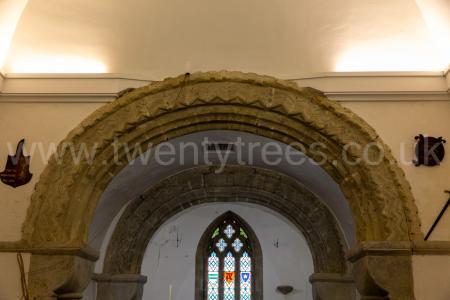
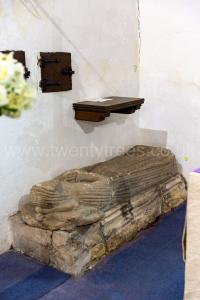
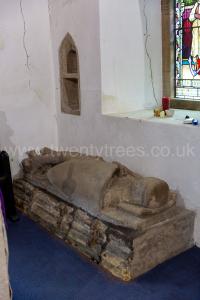
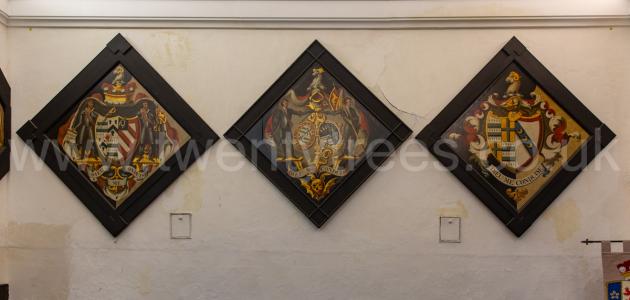
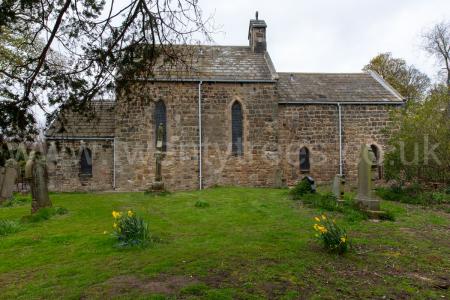
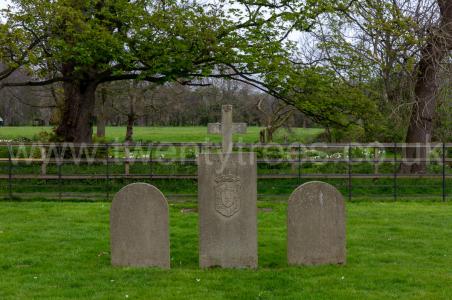
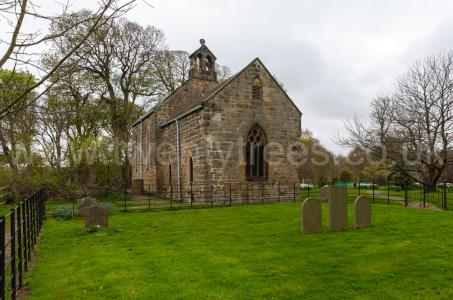
Effigy of Robert de Vere, Earl of Oxford. ROBERT, son of Aubrey de Vere, Earl of Oxford, succeeded his brother Aubrey in the honours and possessions of his family in 1214. He was one of the principal Barons who took up arms against King John, for which he was excommunicated by Pope Innocent the Third. On the accession of Henry the Third (age 14) he was received into favour, and became a Judge in the King's Courts. He married Isabella (age 48), the sister and inheritrix of Hugh de Bolebec, by whom he had a son and heir, Hugh. He died in the fifth year of the reign of Henry the Third, and was buried in the chancel of the Priory Church of Hatfield Broad Oak, in Essex. At the dissolution, Weever says, his tomb was removed into the parish church, and thus transcribes his epitaph:

Sire Robert de Veere le premier, Count de Oxenford ie tierz, git ci; Dieu de l'alme si luy plest face merci. Qi pur l'ame priera xl jors de pardonn avera. Pater Nostera.
This figure lies cross-legged, and is represented in the act of drawing his sword. The loose fit of the hauberk about the right-arm and neck is admirably expressed, and the mails are sculptured with great accuracy. The thighs appear to be covered with a gamboised or quilted defence, which reaches to the knees, the caps of which are defended by octangular pieces of plate-armour. The shield is curiously diapered with fleurs-de-lys and roses. The ground of the held in ancient bearings is often enriched with fanciful ornaments which have no relation whatever to the coat itself. De Vere bore, quarterly Or and Gules, in the first quarter a mullet Argent. This monument, from the costume, appears to have been erected about fifty years after the Earls decease.
Details. Diaper work on the shield enlarged. Band on the hood enlarged.
Before 1260 . The Early Medieval Period Period describes knights wearing a single piece of Chain Mail that covered the head, torso, arms and legs to the knees. Commonly associated with Crusader knights. There are theories crossed-legs mean the knight had been on Crusade, the number of times described by whether the legs are crossed at the ankles, the calves or the knees. None of these theories appear consistent with the extant examples. There are further theories about whether the meaning of Crossed Legs being crossed Right Leg over Left or vice-verse. These, also, do not appear consistent with extant examples.
Before 1400. Various Early Medieval effigies including one with Crossed Legs. St Andrew's Church, Brympton d'Evercy [Map].
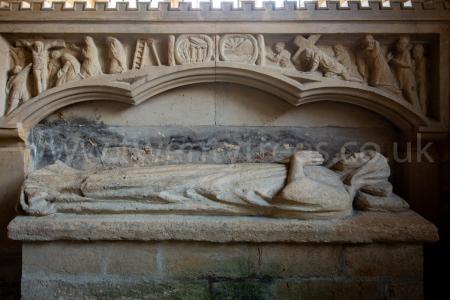
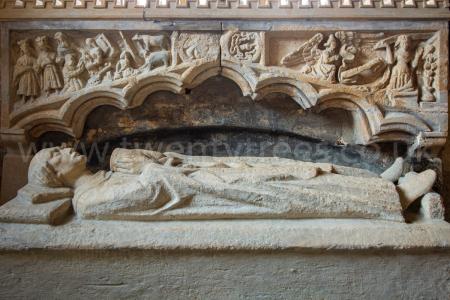
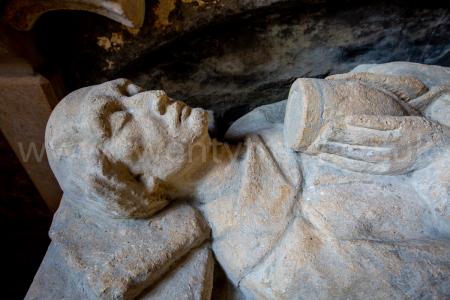
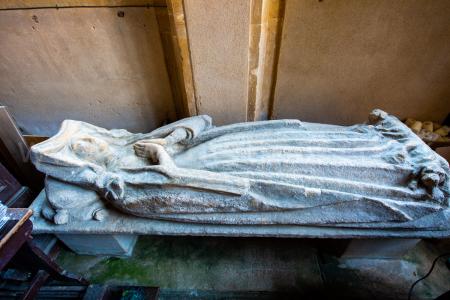
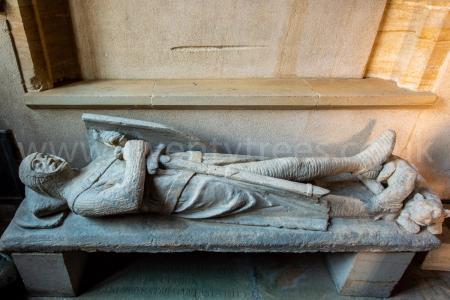
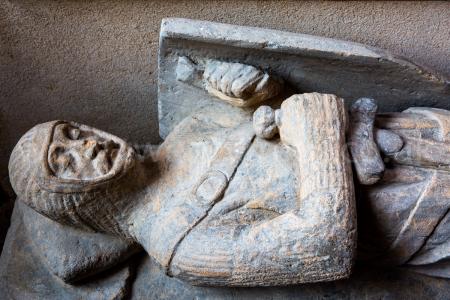
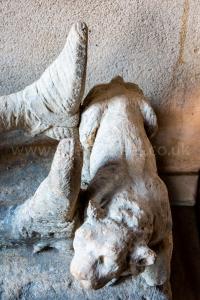
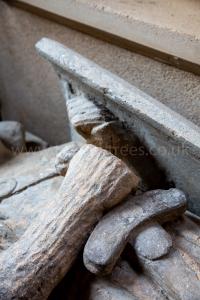
Effigy of Robert Ros. [Robert Ros] WAS descended from the noble family of Ros or Roos, of Hamlake. His father Everard died when he was thirteen years of age, and he had livery of his lands from the wardship of the Crown in the second year of the reign of Richard I. on payment of a hne of one thousand marks; which shows that his possessions must have been very large.
He was one of the Barons who leagued together to obtain the Great and the Forest Charter from John; and when that King had signed them at Runnemede, he was one of the chief persons who undertook to constrain him to observe thema He married Isabella, the daughter of William the Lion, King of Scotland, by whom he had two sons, William and Robert. He gave the first his castle of Helmesley [Map], with the patronage of the monasteries of Kirkham, Rievaulx [Map], and Warden, to the other his castle of Werke and a barony in Scotland, held by knight's service of his brother-in-law. Of both the above-mentioned castles he was the founder. He confirmed to the Templars his manor of Ribstone, with other possessions, assumed the habit of their order, died in 1231, and was buried in the Temple church [Map]. The effigy of Ros is cross-legged, and his hands raised in the act of prayer; the hood of his hauberk is thrown back to show his visage. His sword depends from a belt adorned with broad studs; his surcoat reaches to his heels, which are armed with the pryck spur, and rest on a lion. On his shield are three water bougets, which were the bearing of Ros, Argent, in a held Gules. This figure, like that of Robert de Vere, is of a period subsequent to that of the decease of the person whom it is said to represent.

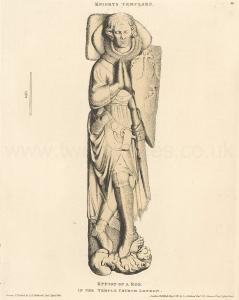
Effigy of Knights Templar. Matthew Paris says that William Marshal, the elder Earl of Pembroke, was buried in the middle of the church of the New Temple; and near their father were also interred two of his sons, William and Gilbert, successive Earls of Pembroke. And from other authorities, we learn that Geoffrey Magnavide, Earl of Essex, and William Plantagenet, fourth son of Henry III. [Note. Henry III only had three sons. Possibly fourth son of Henry II?], were likewise buried in this Church [Map]. The effigies, the subject of the present investigation, occupy the centre of the pavement, and are parted off within two enclosures, each surrounded by a low iron railing: the figures are laid side by side, as close to each other as it is possible to place them. In this arrangement it will be seen that there is not that succession in the order of their dates we should have found had this been their original situation. In the South enclosure it may be particularly noticed, where the only three knights, with emblazoned shields are placed together, although of all the figures thus enclosed, they are, in point of date, the most remote from each other. That they have been displaced receives confirmation from a recent circumstance, for during the late repairs of the church, by excavating the ground beneath the S. enclosure, it was discovered that merely these coffin lids (of which the figures, according to ancient custom, were a part) remained, neither the bodies they inclosed, nor the coffins to which they were attached, being found. This want of original locality is probably the cause that we are now unable to identify with certainty any of the persons said to have been here entombed. From the evidence of Camden, Stow, and Dugdale, it appears these changes have taken place since their time. Camden, who does not allude to their situation or arrangement, says, that William Marsha!, the elder, and his two sons, William and Gilbert, were here buried, and that upon the tomb of William the elder, he read on the upper part "Comes Penbrochiae," and upon the sides this verse, "Miles eram Martis, Mars multos vicerat armis was a soldier of Mars, Mars had conquered many by arms]." Stow speaks of "eleven monuments of noblemen in the round walk of this church; eight of them images of armed knights, five lying cross-legged, as men vowed to the Holy Land against the Infidels and unbeleeving Jews; the other three straight-legged; the rest are coaped stones, all of gray marble." Dugdale says, "within a spacious grate of iron in the midst of the round walk under the steeple do lye eight statues in military habits each of them having large and deep shields on their left armes, of which five are cross-legged. There are also three other grave stones lying about five inches above the level ground; on one of which is a large escocheon with a lion rampanta graved thereon." It is clear from Dugdale's account that the whole of the effigies were in his time within one enclosure, and he likewise agrees with Stow in their number and positions, and also to the number of coped stones. There are now, however, six of them cross-legged, and but one coped stone. This discrepancy is accounted for by a record somewhere existing, which states that the cross-legged figure bearing on his shield the arms of Ross, was brought from Yorkshire, and placed with the other effigies in the Temple Churchb, and it is almost conclusive from the situation of this figure, that whenever its removal took place, the whole of these statues received their present arrangement, and the two coped stones wanting were taken away or destroyed. Upon examining the effigies, to whom the inscriptions given by Camden could possibly be applied, it was found that they were carved in a stone best known under the name of Sussex marble, upon the surface time had effected scarcely any change, and the sides (where inscriptions are sometimes found) buried below the pavement, were ascertained to be as smooth and perfect in most places, as when finished by the sculptor; consequently had the inscriptions ever existed on these coffin lids, they must have been detected. This contradiction to Camden's account cannot readily be reconciled, unless the inscriptions in question were found elsewhere, or on the coped stone wanting, described by Dugdale as having graved upon it an escutcheon, charged with a lion rampant.

Note a. The  Marshal Arms Earls of Pembroke were, party per pale or, and vert, a lion rampant gules.
Marshal Arms Earls of Pembroke were, party per pale or, and vert, a lion rampant gules.
Note b. The note containing the authority for this fact has been mislaid and lost.
Introduction. "Knights being represented cross-legged was certainly allusive to Templars, or Knights of the Holy Voyage; as after Edward the Thirds reign (in which the order was dissolved) we find no monuments in that fashion.
St Mary's Church, Kirkby Fleetham [Map]. Monuments:
Cross-legged effigy of Sir Nicholas Stapleton, died 1290, in good condition, lion at feet, sword, shield and chainmail helmet. Now resting in C19 pointed-arched niche on blind quatrefoiled chest.
William Lawrence, died 1785, by Flaxman. A bust of a young man on a round pillar, with mourning woman to one side, his wife Anne Sophie, heiress to the Studley Royal estate. This is set against a grey marble slab with a pointed-arched top..